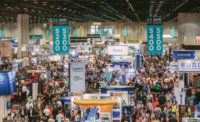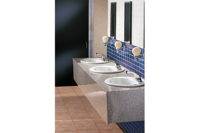It also can be said that the enjoyment of great art requires an environment into which nature cannot intrude. Such an environment now exists at a cultural campus in the heart of the Nevada desert, a place where nature never ends but rather works hard to impose itself.
Article Index:
The new Smith Center for the Performing Arts in downtown Las Vegas is a world-class cultural facility comprising three theaters and a major children’s museum. The multi-building complex cost more than $470 million to build, but more than that, it is the first performing arts center in the nation to be LEED Gold certified. It also is an environment where art can be truly enjoyed.
Since the project’s inception in 2009, the goal of creating a highly efficient and sustainable campus guided the design and construction process. Careful consideration was given to every detail of the facility from the selection and disposal of construction materials to insulation values. The ultimate goal was two-fold: ensure theater occupants remain comfortable during the intensely hot summer months and, paradoxically, keep energy costs to a minimum.
To control both comfort and energy, ABS Systems installed a Delta Controls BACnet building automation system to regulate and monitor the entire HVAC system.
Chilled water system
When temperature conditions require chiller operation, the Delta system controls the chiller plant in a variable-primary system arrangement, eliminating the need for a second set of chilled water pumps. The system continually resets the chilled water supply temperature based on demand to ensure the least amount of energy is used to satisfy the building.
The chillers are controlled to manage their designed Delta-T at all times and the pumps are controlled to provide the exact amount of chilled water flow. The pumps must do this while maintaining the delicate balance of controlling the system Delta-T and ensuring minimum system head is maintained to produce adequate flow throughout the buildings. This is a more efficient control method compared to a primary-secondary chilled water distribution system.
The primary chilled water pumps are managed through their variable frequency drives and control systems to maintain a specific pressure set point in the chilled water piping. They also are responsible for pumping water through the chillers. In order to maintain minimum chilled water flow to the chillers, the system has a bypass control valve responsible for circumventing supply chilled water to the return. Thus, the unit always has a minimum amount of flow through its evaporator, making it an important control element in the variable primary chiller plant.
One of the most cost-effective methods of operating the chilled water pumps is through efficient control sequencing. For example, instead of running one 100 hp pump at 100% speed to maintain the required flow, greater efficiency is achieved running two 100 hp pumps at 50% speed for each pump. Because of the pump affinity laws, the 100 hp pump operating at 100% is operating around 75-80 kW whereas two 100 hp pumps operating at 50% are running at a much lower energy consumption (totaling around 18-22 kW). Controlling the pumps at half the speed results in the pumps running at 1/8 of their power, creating greater efficiency overall.
Condenser loop control
The condenser loop also plays a critical role. An area of energy efficiency deals with the control of the cooling towers. A low condenser water temperature is maintained to increase chiller efficiency, and similar to controlling chilled water pumps, proper control sequencing of the cooling tower fan and pump motors provides additional energy savings.
The condenser water pump VFDs are controlled at the level of speed required to maintain the proper Delta-T at the chiller. When conditions permit, two cooling towers are controlled by operating at lower speeds (through their fan VFD) rather than operating one tower at a higher speed. A similar example can be drawn from the 100 hp pump reference above.
The air-handling systems also have an important role in the Smith Center’s energy optimization strategies. When air-handling systems are efficiently operating, there is a positive effect on the chiller plant operation and its ability to maintain the proper Delta-T.
The Smith Center air handlers were designed with a specified Delta-T and operate at full design parameters to maintain maximum efficiency. Maintaining the supply air temperature is critical. If the set point is too low, the cooling valve can open to 100% flow to the cooling coil, but the new set point can never be achieved.
For example, a change in the supply air set point of just 3° F can potentially double the amount of flow through the coil. The result of this high flow can decrease the Delta-T at the plant.
The air handlers, equipped with VFDs on the fans for supply duct pressure control, serve a number of VAV terminals located throughout the facility. In addition, full outside air economizers are controlled whenever conditions permit. The theaters are equipped with carbon dioxide sensors (CO2) to sense when occupancy is rising so the building management system can provide a higher amount of outside air to control the CO2 levels in the space.
Prior to a show, the theater is pre-cooled to ensure temperature can be maintained throughout the performance. Further, when the theaters are unoccupied, the amount of minimum outside air ventilation is reduced, which results in further energy savings.
In addition, the building management system monitors the electrical, gas, and water meters and provides an account of energy usage to the owner on a constant basis.
Keeping it efficient
Other sustainable features at the Smith Center include low-flow and ultra-low flush fixtures, native plants using drip irrigation, energy-efficient glazing and wall assembly, and use of natural light wherever possible. All of the mechanical equipment is regularly maintained in accordance with manufacturers’ recommendations to assure continued efficiency in the HVAC system.
The chiller barrels regularly are cleaned and the cooling towers are maintained to assure a consistent, high-quality heat exchange in the chilled and condenser water loops. The owner also has a comprehensive water treatment program as a further means to keep the efficiency at a high level.
ABS Systems performs a preventative maintenance program for the building automation system and is able to address many potential issues in the system, thus avoiding expensive repairs while keeping the energy use in check.
Tim Potter is the vice president of ABS Systems, a division of Southland Industries. Potter is involved with the American Society of Heating, Refrigeration and Air Conditioning Engineers, Associated Builders & Contractors, Associated General Contractors and the United States Green Building Council, Nevada Chapter.





